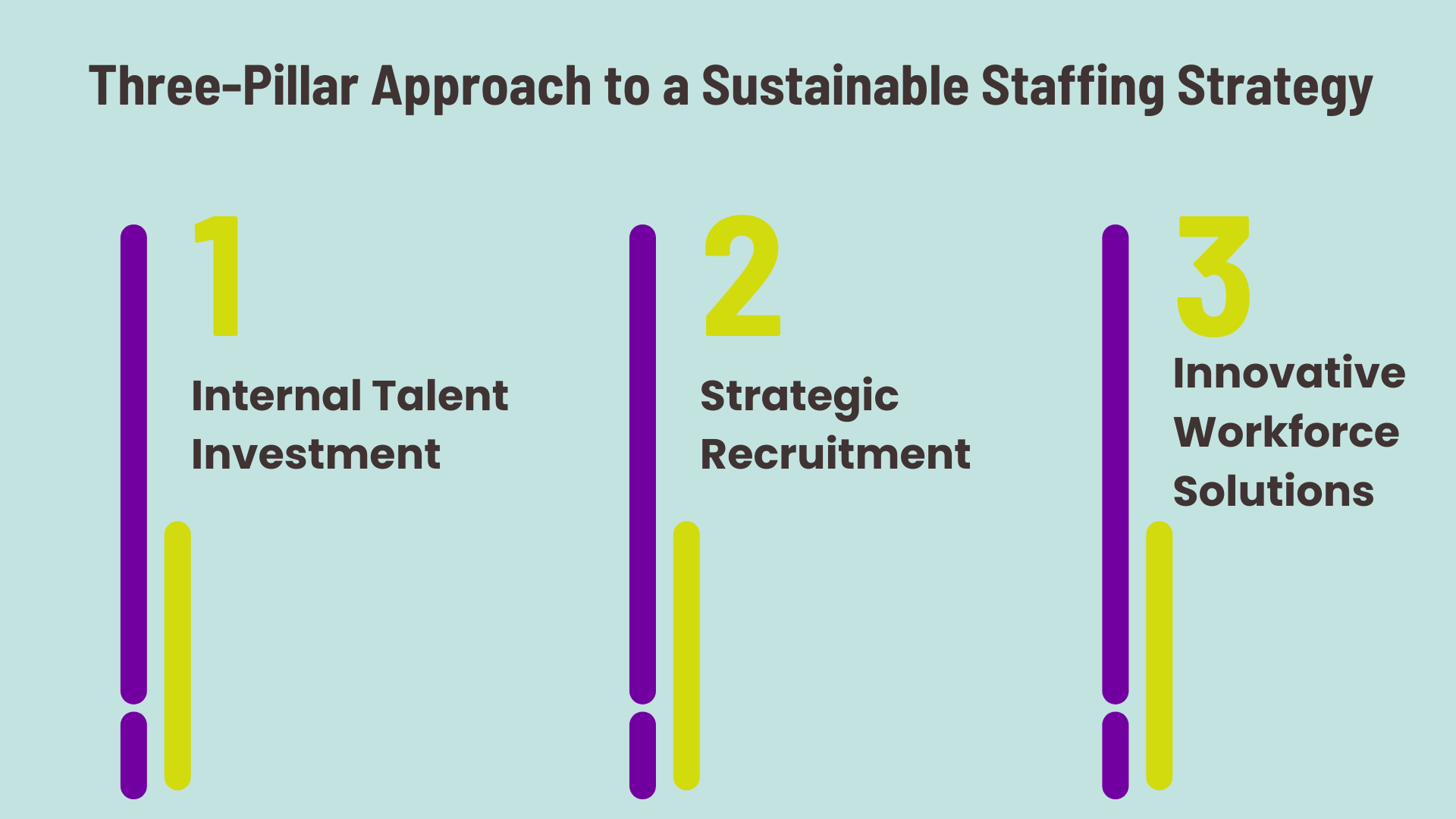Navigating Staffing Shortages: Why Outsourcing Isn't the Only Answer

It's 3 AM in a bustling emergency department. The night shift supervisor glances at the overflow of patients in the waiting room, then at the clock. Two nurses have called in sick, and the department is short-staffed — again. As the supervisor reaches for the phone to call a staffing agency, there's a moment of hesitation. Is this really the best way to handle these recurring shortages?
This scenario plays out nightly in hospitals across the country. According to the Health Resources and Services Administration (HRSA) Nurse Workforce Projections: 2026-2031 report issued in March 2024, there will be nurse shortages expected until 2036. The knee-jerk reaction? Outsourcing. But as healthcare leaders, we need to ask: Is this quick fix truly solving our long-term staffing challenges?
While outsourcing often emerges as a go-to solution, it's crucial to recognize that it's not the only answer to this complex problem. Let's explore why a more comprehensive approach, focusing on internal talent development, strategic recruitment, and innovative scheduling, can provide more sustainable solutions to healthcare staffing challenges.

The Role of Outsourcing in Modern Healthcare Staffing
Outsourcing healthcare staff plays a vital role in today's dynamic healthcare environment. It offers healthcare facilities the flexibility to maintain quality care during peak demand periods, staff shortages, or unexpected absences.
While outsourcing and per diem staffing provide crucial support, healthcare leaders are increasingly recognizing the need for a more comprehensive approach to staffing challenges. Let's explore why a multi-faceted strategy is essential:
Cost Management: While flexible staffing solutions offer immediate relief, the American Hospital Association reports that hospitals are continuing to spend more on contract labor compared to pre-pandemic levels, calling out a 258% surge from 2019 to 2022 nationwide. This underscores the need for additional long-term strategies to optimize staffing costs.
Consistency in Care: Integrating temporary staff seamlessly into existing teams can be challenging. By utilizing highly qualified on-demand nurses through ShiftMed for clinical support, SSM Health has enhanced care quality and safety ratings, achieved higher patient satisfaction scores, and decreased catheter-associated urinary tract infections and central-line-associated bloodstream infections.
Team Dynamics: Building a cohesive team culture requires a stable workforce core. Blending permanent staff with flexible staffing options allows for both stability and adaptability.
Long-term Workforce Planning: While outsourcing and per diem staffing address immediate needs, healthcare organizations benefit from simultaneously developing strategies for long-term workforce sustainability.
By recognizing both the benefits of flexible staffing solutions and the importance of comprehensive workforce strategies, healthcare organizations can create a more resilient and adaptive staffing model.
Building a Sustainable Staffing Strategy: The Three-Pillar Approach
Instead of relying solely on outsourcing, healthcare organizations can benefit from a multi-faceted approach that combines internal talent development, strategic recruitment, and innovative scheduling practices.

1. Investing in Internal Talent Development
Nurturing your existing workforce is a powerful strategy for mitigating staffing shortages. By focusing on internal talent development, you can create a more resilient and engaged team while reducing turnover. Consider implementing:
Comprehensive Training Programs: Offer ongoing education and skill development opportunities to help staff grow within your organization.
Leadership Development Initiatives: Identify and nurture potential leaders from within, creating a pipeline for future management positions.
Career Advancement Pathways: Provide clear paths for career progression, encouraging staff to envision a long-term future with your organization.
2. Strategic Recruitment: Building a Long-Term Pipeline
While developing internal talent is crucial, strategic recruitment practices are equally important for building a sustainable workforce pipeline. Focus on:
Employer Branding: Develop a strong employer brand that showcases your organization's culture, values, and opportunities for growth.
Partnerships with Educational Institutions: Forge relationships with nursing schools and other healthcare education programs to create a direct pipeline of new talent.
Proactive Talent Acquisition: Implement strategies to attract passive candidates and build a pool of potential hires before urgent needs arise.
By taking a proactive approach to recruitment, you can reduce reliance on outsourcing and build a workforce that aligns with your organization's long-term goals.
3. Embracing Innovative Scheduling Solutions
Optimizing your current workforce through innovative scheduling can significantly reduce the need for outsourced staff. Consider implementing:
Flexible Shift Options: Offer a variety of shift lengths and start times to accommodate diverse employee needs and preferences. According to Julie Fetto, MBA, BSN, RN, NE-BC, Chief Nursing Officer of Cleveland Clinic Medina Hospital, “As the healthcare industry continues to evolve in complexity, now more than ever it is incumbent upon us to innovate and embrace flexibility to address the needs of our caregivers.”
Self-Scheduling Tools: Empower staff to have more control over their schedules, increasing job satisfaction and retention. With ShiftMed Flex, hospitals can utilize custom mobile app technology to harness the power of their internal staff to fill shift vacancies before turning to external solutions.
PRN (As-Needed) Pools: Develop a robust pool of part-time or per-diem staff who can fill gaps without the need for external agencies. Effective use of internal PRN pools can reduce reliance on agency staff.
Leveraging workforce management technology can streamline these processes, making it easier to match staffing levels with patient needs while improving employee satisfaction.
The Path Forward: Cultivating a Resilient Healthcare Workforce
While outsourcing can play a role in managing short-term staffing challenges, a truly sustainable solution requires a more comprehensive strategy. By combining internal talent development, strategic recruitment, and innovative scheduling practices, healthcare organizations can build a resilient workforce capable of meeting both current and future staffing needs.
This approach not only addresses immediate staffing shortages but also contributes to:
Improved quality of care through a more stable and experienced workforce
Enhanced team cohesion and organizational culture
Reduced long-term costs associated with high turnover and premium outsourcing fees
Increased employee satisfaction and engagement
As healthcare leaders navigate the ongoing challenge of staffing shortages, it's crucial to look beyond quick fixes and invest in long-term solutions. By prioritizing internal talent development, implementing strategic recruitment practices, and embracing innovative scheduling, organizations can build a workforce that not only meets current demands but is also prepared for future challenges.
Ready to transform your approach to healthcare staffing? Discover how ShiftMed's workforce management solutions can help you build a sustainable, efficient, and engaged healthcare workforce. Don't let staffing shortages hold your organization back. Contact ShiftMed today to learn how we can help you cultivate a thriving, resilient healthcare workforce that's built to last.